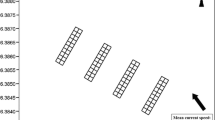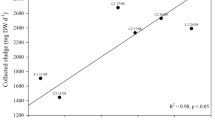Abstract
Spiny lobster aquaculture in sea-cages produces both particulate (faeces and waste feed) and soluble wastes [dissolved inorganic nitrogen (DIN)] that have the potential to degrade the environment. To begin to understand the environmental impacts of tropical spiny lobster aquaculture, the waste products of these lobsters were quantified, including the settling velocity of faecal material and DIN output from lobsters of a range of sizes and fed two dietary treatments (seafood and artificial diet), as well as determining the nitrogen leaching from faeces and diets for lobsters. The mean faeces settling velocity of lobsters fed with seafood was significantly higher than those from lobsters fed with artificial diet (0.30 ± 0.01 and 0.22 ± 0.01 cm s−1, respectively, mean ± SE), but the settling velocity of faeces did not differ among the lobsters of different sizes for each diet. The settling velocity of faecal material showed a positive relationship with faeces weight, volume and density but not length. Both carbon and nitrogen content in faeces showed no significant differences between the two diets. Feeding activity doubled the DIN output from lobsters consistently for both dietary treatments compared with unfed lobsters. Nutrient leaching from samples of faeces and diet was highly variable and did not differ among lobsters of different sizes or between the two dietary treatments. Overall, while faecal material, waste feed, as well as DIN excretion by lobsters in aquaculture operations could potentially negatively impact the environment, their faeces settling velocity and DIN output is markedly lower than fin-fish. Thus, the environmental impact from lobster aquaculture is unlikely to be as intensive as for fin-fish aquaculture.





Similar content being viewed by others
Abbreviations
- TAN:
-
Total ammonical nitrogen
- DIN:
-
Dissolved inorganic nitrogen
- FCR:
-
Feed conversion ratio
References
Arcenal JMM (2004) Sustainable farming of spiny lobster in Western Mindanao, Philippines. In: Williams KC (ed) Spiny lobster ecology and exploitation in the South China Sea region. Proceedings of a workshop held at the Institute of Oceanography, Nha Trang, Vietnam, July 2004. ACIAR proceedings no. 120, Australian Centre for International Agricultural Research, Canberra, pp 19–20
Ballestrazzi R, Lanari D, D’Agaro E, Mion A (1994) The effect of dietary protein level and source on growth, body composition, total ammonia and reactive phosphate excretion of growing sea bass (Dicentrarchus labrax). Aquaculture 127:197–206
Beveridge M (2004) Cage aquaculture, 3rd edn. Blackwell, Oxford
Binns R, Peterson AJ (1969) Nitrogen excretion by the spiny lobster Jasus edwardsi (Hutton): the role of the antennal gland. Biol Bull 136:147–153
Brooks KM, Mahnken C, Nash C (2002) Environmental effects associated with marine netpen waste with emphasis on salmon farming in the Pacific Northwest. In: Stickney RR, McVey JP (eds) Responsible marine aquaculture. CAB International, Cambridge, pp 159–204
Burford MA, Williams KC (2001) The fate of nitrogenous waste from shrimp feeding. Aquaculture 198:79–93
Chen YS, Beveridge MCM, Telfer TC (1999) Settling rate characteristics and nutrient content of the faeces of Atlantic salmon, Salmo salar L., and the implications for modelling of solid waste dispersion. Aquac Res 30:395–398
Chen YS, Beveridge MCM, Telfer TC, Roy WJ (2003) Nutrient leaching and settling rate characteristics of faeces of Atlantic salmon (Salmo salar L.) and the implications for modelling of solid waste dispersion. J Appl Ichthyol 19:114–117
Crear B, Forteath GNR (2002) Feeding has the largest effect on the ammonia excretion rate of the southern rock lobster, Jasus edwardsii, and the western rock lobster, Panulirus cygnus. Aquac Eng 26:239–250
Cromey CJ, Nickell TD, Black KD (2002) DEPOMOD—modelling the deposition and biological effects of waste solids from marine cage farms. Aquaculture 21:211–239
Cromey CJ, Nickell TD, Treasurer J, Black KD, Inall M (2009) Modelling the impact of cod (Gadus morhua L.) farming in the marine environment—CODMOD. Aquaculture 289:42–53
Doglioli AM, Magaldi MG, Vezzulli L, Tucci S (2004) Development of a numerical model to study the dispersion of wastes coming from a marine fish farm in the Ligurian Sea (Western Mediterranean). Aquaculture 231:215–235
Gowen RJ, Bradbury NB, Brown JR (1989) The use of simple models in assessing two of the interactions between fish-farming and the marine environment. In: De Pauw N, Jaspers E, Ackerfors H, Wilkins N (eds) Aquaculture—a biotechnology. European Aquaculture Society, Belgium, pp 1071–1080
Hartstein ND, Rowden AA (2004) Effect of biodeposits from mussel culture on macroinvertebrate assemblages at sites of different hydrodynamic regime. Mar Environ Res 57:339–357
Hawkins CM, Castell JD, Leroyer V (1986) Patterns and rates of ammonia excretion by juvenile American lobsters, Homarus americanus, fed casein- and crab protein-based diets. Can J Fish Aquat Sci 43:1290–1294
Hung LV, Tuan LA (2009) Lobster seacage culture in Vietnam, In: Williams KC (ed) Spiny lobster aquaculture in the Asia-Pacific region. Proceedings of an international symposium held at Nha Trang, Vietnam, 9–10 December 2008. ACIAR proceedings no. 132. Australian Centre for International Agricultural Research, Canberra, pp 10–17
Irvin SJ, Tabrett SJ (2005) A novel method of collecting fecal samples from spiny lobsters. Aquaculture 243:269–272
Johnston DJ (2003) Ontogenetic changes in digestive gland activity of spiny lobster Jasus edwardsii (Decapoda; Palinuridae). Mar Biol 143:1071–1082
Kemp JOG, Britz PJ, Cockcroft AC (2009) Ammonia excretion dynamics in the east coast rock lobster Panulirus homarus rubellus. Aquaculture 286:296–300
Lee S, Hartstein N, Wong KY, Jeffs AG (2014) Assessment of the production and dispersal of faecal waste from the sea-cage aquaculture of spiny lobsters. Aquac Res. doi:10.1111/are.12618
Lee S, Hartstein N, Jeffs AG (2015) Characterising the fate of nitrogenous waste from the sea-cage aquaculture of spiny lobsters using numerical modelling. Environ Sci Pollut Res. doi:10.1007/s11356-014-4035-9
Leung KMY (1996). The nitrogen budgets of the areolated grouper Epinephelus areolatus (Forskal) and the mangrove snapper Lutjanus argentimaculatus (Forskal) cultured in open sea cages. Unpublished master’s thesis, City University of Hong Kong
Magill SH, Thetmeyer H, Cromey CJ (2006) Settling velocity of faecal pellets of gilthead sea bream (Sparus aurata L.) and sea bass (Dicentrarchus labrax L.) and sensitivity analysis using measured data in a deposition model. Aquaculture 25:295–305
Moccia R, Bevan D, Reid G (2007) Composition of feed and fecal waste from commercial trout farms in Ontario: physical characterization and relationship to dispersion and depositional modelling. Final report submitted to the: Ontario sustainable aquaculture working group environment Canada. University of Guelph, Guelph
Ogunkoya AE, Page GE, Adewolu MA, Bureau DP (2006) Dietary incorporation of soybean meal and exogenous enzyme cocktail can affect physical characteristics of faecal material egested by rainbow trout (Oncorhynchus mykiss). Aquaculture 254:466–475
Pearson TH, Black KD (2001) The environmental impacts of marine fish cage culture. In: Black KD (ed) Environmental impacts of aquaculture. Sheffield Academic Press Ltd., Sheffield
Pérez Ó, Almansa E, Riera R, Rodriguez M, Ramos E, Costa J, Monterroso Ó (2014) Food and faeces settling velocities of meagre (Argyrosomus regius) and its application for modelling waste dispersion from sea cage aquaculture. Aquaculture 420–421:171–179
Phillips B, Matsuda H (2011) A global review of spiny lobster aquaculture. In: Fotedar R, Phillips B (eds) Recent advances and new species in aquaculture. Blackwell, Sussex, pp 22–84
Piedecausa MA, Aguado-Giménez F, García-García B, Ballester G, Telfer T (2009) Settling velocity and total ammonia nitrogen leaching from commercial feed and faecal pellets of gilthead seabream (Sparus aurata L. 1758) and seabass (Dicentrarchus labrax L. 1758). Aquac Res 40:1703–1714
Priyambodo B, Sarifin (2008) Lobster aquaculture industry in eastern Indonesia: present status and prospects, In: Williams KC (ed) Spiny lobster aquaculture in the Asia-Pacific region. Proceedings of an international symposium held at Nha Trang, Vietnam, 9–10 December 2008. ACIAR proceedings no. 132, Australian Centre for International Agricultural Research, Canberra, pp 36–45
Radford CA, Marsden ID, Davison W (2004) Temporal variation in the specific dynamic action of juvenile New Zealand rock lobsters, Jasus edwardsii. Comp Biochem Physiol A: Mol Integr Physiol 139:1–9
Reid GK, Liutkus M, Robinson SMC, Chopin TR, Blair T, Lander T, Mullen J, Page F, Moccia RD (2009) A review of the biophysical properties of salmonid faeces: implications for aquaculture waste dispersal models and integrated multi-trophic aquaculture. Aquac Res 40:257–273
Simon CJ (2009a) The effect of carbohydrate source, inclusion level of gelatinised starch, feed binder and fishmeal particle size on the apparent digestibility of formulated diests for spiny lobster juveniles, Jasus edwardsii. Aquaculture 296:329–336
Simon CJ (2009b) Feed intake and its relation to foregut capacity in juvenile spiny lobsters, Jasus edwardsii. N Z J Mar Fresh Res 43:195–203
Simon CJ, Jeffs A (2008) Feeding and gut evacuation of cultured juvenile spiny lobster, Jasus edwardsii. Aquaculture 280:211–219
Smith DM, Williams KC, Irvin SJ (2005) Response of the tropical spiny lobster Panulirus ornatus to protein content of pelleted feed and to a diet of mussel flesh. Aquac Nutr 11:209–217
Tlusty MF, Snook K, Pepper VA, Anderson MR (2000) The potential for soluble and transport loss of particulate aquaculture wastes. Aquac Res 31:745–755
Wu RSS (1995) The environment impact of marine fish culture: towards a sustainable future. Mar Pollut Bull 31:159–166
Zoutendyk P (1987) Nitrogen excretion by the Cape rock lobster Jasus lalandii and its possible contribution to the inshore Benguela system. S Afr J Mar Sci 5:565–574
Acknowledgments
The research was conducted in a manner that was consistent with protocols approved under University of Auckland Animal Ethics Committee approval number R929. Much appreciation to both Matthew Johnston and Andrea Denim for technical support. The authors would also like to thank Universiti of Sains Malaysia for providing assistance with the elemental analysis of faecal material.
Author information
Authors and Affiliations
Corresponding author
Rights and permissions
About this article
Cite this article
Lee, S., Hartstein, N.D. & Jeffs, A. Characteristics of faecal and dissolved nitrogen production from tropical spiny lobster, Panulirus ornatus . Aquacult Int 23, 1411–1425 (2015). https://doi.org/10.1007/s10499-015-9893-8
Received:
Accepted:
Published:
Issue Date:
DOI: https://doi.org/10.1007/s10499-015-9893-8




